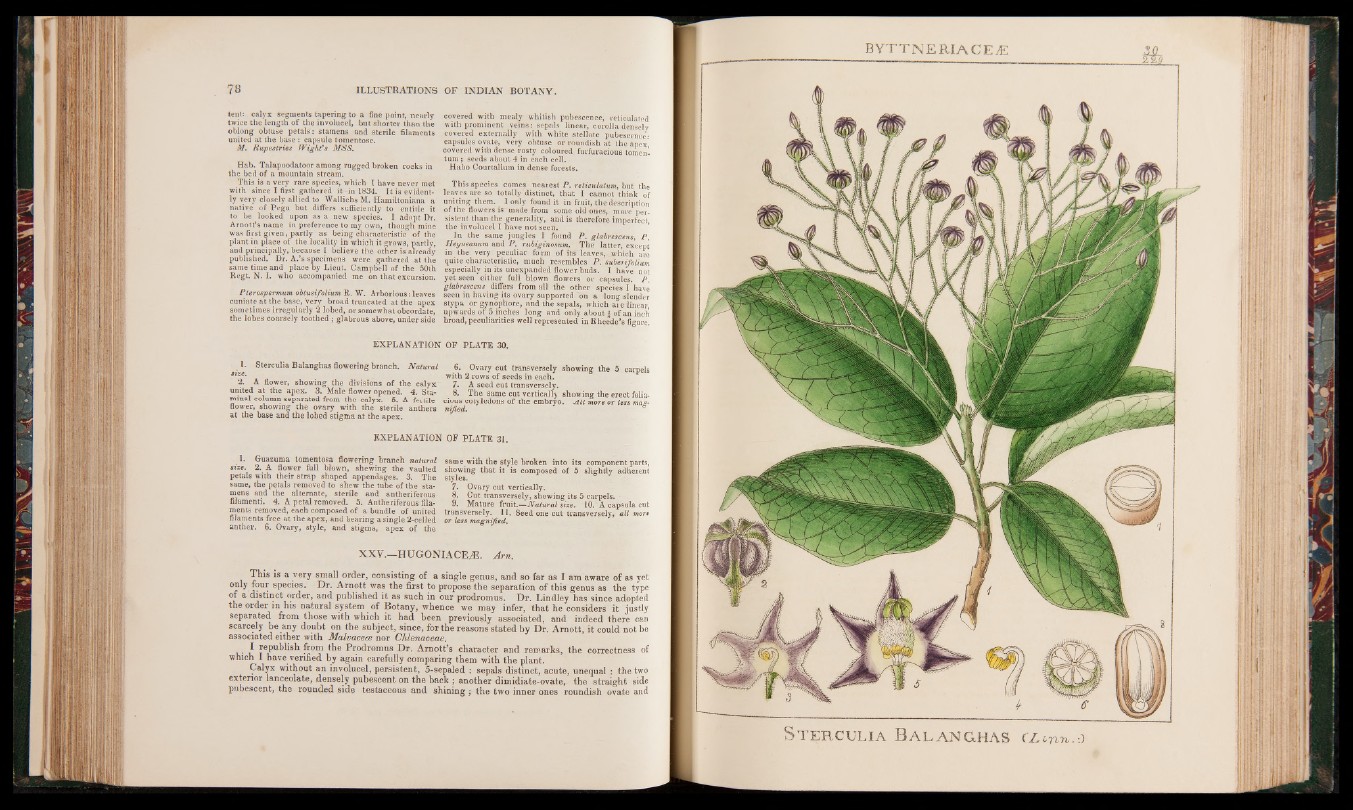
tent: calyx segments tapering to a fine point, nearly
twice the length of the involucel, but shorter than the
oblong obtuse petals: stamens and sterile filaments
united at the b a se: capsule tomentose.
M. Ru-pestries Wight's M S S .
Hab. Talapoodatoor among rugged broken rocks in
the bed of a mountain stream.
This is a very rare species, which I have never met
with since I first gathered it-in 1834. It is evidently
very closely allied to Wallichs M. Hamiltoniana a
native of Pegu but differs sufficiently to entitle it
to be looked upon as a new species. I adopt Dr.
Arnott*s name in preference to my own, though mine
was first given, partly as being characteristic of the
plant in place of the locality in which it grows, partly,
and principally, because I believe the other is already
published. Dr. A.’s specimens were gathered at the
same time and place by Lieut. Campbell of the 50th
Regt. N. I. who accompanied me on that excursion.
Pterospermum obtusifolium R. W. Arborious: leaves
cuniate at the base, very broad truncated at the apex
sometimes irregularly 2 lobed, or somewhat obcordate,
the lobes coarsely toothed ; glabrous above, under side
EXPLANATION
1. Sterculia Balanghas flowering branch. Natural
size.
2. A flower, showing the divisions of the calyx
united at the apex. 3. Male flower opened. 4. Sta-
minal column separated from the calyx. 5. A fertile
flower, showing the ovary with the sterile anthers
at the base and the lobed stigma at the apex.
EXPLANATION
1. Guazuma tomentosa flowering branch natural
size. 2. A flower full blown, shewing the vaulted
petals with their strap shaped appendages. 3. The
same, the petals removed to shew the tube of the stamens
and the alternate, sterile and antheriferous
filamenti. 4. A petal removed. 5. Antheriferous filaments
removed, each composed of a bundle of united
filaments free at the apex, and bearing a single 2-celled
anther. 6. Ovary, style, and stigma, apex of the
covered with mealy whitish pubescence, reticulated
with prominent veins: sepals linear, corolla densely
covered externally with white stellate pubescence:
capsules ovate, very obtuse or roundish at the Apex,
covered with dense rusty coloured furfuracious tomen-
turn; seeds about 4 in each cell.
Habo Courtallum in dense forests.
This species come? nearest P. reticulatum, but the
leaves are so totally distinct, that I cannot think of
uniting them. I only found it in fruit, the description
of the flowers is ''made from some old ones, more persistent
than the generality, and is therefore imperfect
the involucel I nave not seen.
In the same jungles I found P . glabrescens, P.
Heyneanum and P. rubiginosum. The latter, except
in the very peculiar form of its leaves, which are
quite characteristic, much resembles P . suberifolium
especially in its unexpanded flower.buds. I have not
yet seen either full blown flowers or capsules. P.
glabrescens differs from all the other species I have
seen in having its ovary supported on a long slender
stypa or gynophore, and the sepals, which are linear,
upwards of 5 inches long and only about x of an inch
broad, peculiarities well represented in Rheede’s figure,
OF PLATE 30.
6. Ovary cut transversely showing the 5 carpels
with 2 rows of seeds in each.
7. A seed cut transversely.
8. The same cut vertically showing the erect fallacious
cotyledons of the embryo. A ll more or less magnified.
OF PLATE 31.
same with the style broken into its component parts,
showing that it is composed of 5 slightly adherent
styles.
7- Ovary cut vertically.
8. Cut transversely, showing its 5 carpels.
9. Mature fruit.—Natural size. 10. A capsula cut
transversely. 11. Seed one cut transversely, all more
or less magnified,
XXV.—HUGONIACEA3. Arn,
This is a very small order, consisting of a single genus, and so far as I am aware of as yet
°? ■ sPec*es* -^r' Arnott was the first to propose the separation of this genus as the type
u a jS order, and published it as such in our prodromus. Dr. Lindley has since adopted
the order in his natural system of Botany, whence we may infer, that he considers it justly
separated from those with which it had been previously associated, and indeed there can
scarcely be any doubt on the subject, since, for the reasons stated by Dr. Arnott, it could not be
associated either with Malvacece nor Chlenaceae.
I republish from the Prodromus Dr. Arnott’s character and remarks, the correctness of
which I have verified by again carefully comparing them with the plant.
Calyx without an involucel, persistent, 5-sepaled : sepals distinct, acute, unequal : the two
exterior lanceolate, densely pubescent on the back ; another dimidiate-ovate, the straight side
pubescent, the rounded side testaceous and shining; the two inner ones roundish ovate and
B Y T T N E R I A C E Æ
S t e r c u l i a B a l a n u h a s cLcnn.ù